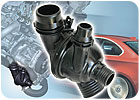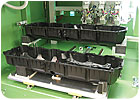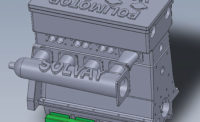
The world beneath the hood of any automobile is a harsh place. High temperatures and constant vibration create severe stress on most parts. Components come in contact with oil, grease, gasoline, transmission fluid, brake fluid, water, ice, road salt, dirt, dust and other elements, not to mention hot and cold temperature extremes. Wear resistance is also critical to any parts that are attached to an engine or mounted nearby.
Traditionally, using any material other than metal in the engine compartment was unthinkable. But, that old rule of thumb is quickly changing. Many automakers and suppliers are using plastics, such as nylon, polyphenylene sulfide and polypropyl-ene, to reduce vehicle weight and improve fuel efficiency. Other benefits include parts consolidation, cost savings, durability, corrosion resistance and sound dampening.
As a result, it’s no longer unusual to open a hood and find plastic air-intake manifolds, valve covers, fuel rails, water pump housings, HVAC systems, brake fluid reservoirs, electronic throttle controls, engine covers, filtration systems and other pow-ertrain parts.
At the SAE Congress in Detroit this month, lightweight materials will be a hot topic. Automotive engineers are scrambling to find ways to meet the new corporate-average fuel economy (CAFE) standard. It requires automakers to increase average fuel economy by 40 percent between now and 2020, without sacrificing safety or cost. Faced with growing pressure to improve fuel efficiency, many engineers are exploring new ways to use plastic to replace traditional metal components.
“CAFE is driving automakers to rethink what’s going on under the hood,” says Paul Spevetz, technical marketing manager for automotive applications at Ticona Polymers Inc. (Florence, KY). “They’re trying to get more power out of smaller dis-placement engines.” That’s forcing engineers to use more components, such as turbochargers, that allow them to create downsized engines that boost fuel economy while reducing CO2 emissions.
“As dimensions become tighter and package size decreases, under-hood plastic applications will rise,” Spevetz predicts. In fact, he says Ticona’s Detroit office has been busier than ever lately, despite the economy. “Everyone is hungry for game-changing ideas. The CAFE standards are challenging engineers to do things differently. They’re willing to try things that ha-ven’t been done in the past.”
That’s evident in the Automotive Innovation Awards Competition, an annual event sponsored by the Society of Plastics En-gineers (SPE, Brookfield, CT), which has seen a steady increase in entries for under-the-hood applications. Even the types of nominations received have changed in recent years.
“A decade ago, it was mostly things like engine beauty shields and air-intake manifolds,” says Peggy Malnati, who adminis-ters the 38-year-old award program. “Now, we’re seeing things like all-plastic oil pans and torque-reaction mounts. In other words, polymeric materials are moving into more difficult applications based on the success of earlier metal-to-plastic trans-lations.”
One of last year’s winners was a hybrid nylon-aluminum oil pan module produced by G. Bruss GmbH (Hoisdorf, Germany) for use in the Mercedes-Benz C Class sedan. It is more than 2 pounds lighter and 20 percent less expensive than its all-aluminum predecessor.
In 2007, an electronic throttle control module made out of thermoset polyester received a first-place award from SPE. The device, supplied by Robert Bosch LLC (Farmington Hills, MI), was used in the Chrysler Pacifica crossover. It replaced a cast aluminum housing, resulting in a 28 percent weight savings and an 18 percent cost savings. In addition, a snap-fit cover eliminated the use of fasteners.
Automakers around the world are on a continuous crusade to reduce weight. For instance, Nissan Motor Co. (Tokyo) plans to make its cars 15 percent lighter by 2015. To tackle that challenge, the company recently started to make plastic rocker covers and front covers for the diesel engines on its Navara and Pathfinder vehicles. By molding the parts from nylon, instead of aluminum, Nissan engineers were able to reduce weight by 40 percent. They achieved similar savings by converting the elec-tric water valve assembly used on the Armada, Quest and Titan from steel to plastic.
Plastic use is expected to increase under the hood as automakers rush to build small, fuel-efficient engines. General Motors Corp. (GM, Detroit) plans to double global production of four-cylinder engines by 2011. Within two years, one-third of all GM engines assembled in North America will be four-cylinder and 21 percent will be turbocharged. During the same time frame, Ford Motor Co. (Dearborn, MI) plans to double production of four-cylinder engines in North America to more than 1 million units.

A New Mindset
The plastic-under-the-hood trend started in Europe, where automakers have long built vehicles equipped with small, fuel-efficient engines. Brian Baleno, global market manager at Solvay Advanced Polymers LLC (Alpharetta, GA), says European engineers tend to be more progressive in their willingness to use plastic for powertrain applications. “[There is a] higher em-phasis in Europe on overall system efficiency and fuel economy gained by using plastic where metals were historically used,” he points out. “This is starting to change in the United States.”European automotive engineers also have been more willing to work closely with materials suppliers to develop plastic-friendly designs. “They have had a long-term, positive experience with thermoplastics,” says Marianne Morgan, marketing sector leader for powertrain at BASF Corp. (Florham Park, NJ). “North American manufacturers had some failures with plas-tics back in the 1980s and 1990s, when their [metal-based] designs were not optimized for plastic material.”
Changing that mindset is one of the biggest challenges to replacing metal powertrain components with plastic. According to Baleno, it’s often not possible to take an existing metal part and simply copy it in plastic. “Parts need to be designed for plastic using computer-aided engineering tools such as finite element analysis,” he explains. “This ensures that parts are designed to withstand [unique under-the-hood] loads and pressures. Weight savings can also be achieved by coring out plastic parts.”
“We have seen a significant increase in the use of plastics for under-the-hood applications,” adds Bill Heatherwick, automo-tive market segment manager at Branson Ultrasonics Corp. (Danbury, CT). “The ongoing performance improvements of plastics in the areas of dimensional stability, and heat and chemical resistance, have made increased use possible. We also have seen perceptions change in terms of the acceptance of plastic as a highly engineered solution. All the major resin suppli-ers have played a key role in educating [engineers].”
Heatherwick says the biggest challenge in moving from metal to plastic has been convincing the automotive engineering community that a plastic solution can perform as well, or better than, metal with the added benefits of weight and cost reduc-tions. “Metal is a known commodity, with reams of performance and testing data to [prove] that it works well,” he explains. “Convincing OEM’s to take the leap to plastic was the toughest hurdle. There is now as much data supporting plastic solu-tions that will meet the test specifications for engine vibration, temperature and chemical resistance.”
For instance, thermoplastics have lower mechanical properties than aluminum and steel. “Those properties change with in-creasing temperatures that are typically found in an under-the-hood environment,” says Dave Conley, application develop-ment manager at DSM Chemicals Inc. (Augusta, GA). “The design of such components to satisfy the functional requirements within economical targets requires a thorough knowledge of the applied stressors.”
Plastic also offers several performance characteristics that create greater rigidity, along with tighter tolerances, than parts made from metal. That allows engineers to reduce a number of metal parts to a single structural part molded out of plastic. Snap-fits, bosses, ribs and other features, such as brackets and attachment points, can be molded in to eliminate assembly steps, reduce weight and reduce part count.
“Design flexibilities allow engineers to simplify parts and integrate different functions,” explains Gianluigi Molteni, global power-train segment manager at DuPont Automotive (Troy, MI). “Molding is also becoming more advanced to allow for more complex designs. That leads to easier packaging and assembly.”
Part design freedom allows automotive engineers to create different geometries that are sometimes not possible with metal. That’s one of the reasons why plastic has become a popular material for air-intake manifolds. The typical nylon manifold weighs 4 to 6 pounds vs. 20 pounds for a cast aluminum part. But, weight savings is only one advantage of using plastic for that application.
“The smooth inside wall of intake channels feature lower drag properties than aluminum,” says Morgan. “Plastic can [also] be shaped more easily, which allows more favorable air flow design.”
“Injection-molded parts offer class-A finishes in internal air-fuel tracts to assist in air flow and engine efficiency,” adds Dan Schewe, regional sales manager at Forward Technology Inc. (Cokato, MN). “Cast parts are typically rough and require substan-tial cleaning and machining. Plastics allow the part designer to use just the right amount of material needed to accommodate the requirements of the job. The wall thickness on an intake manifold is sized not only for normal air flow requirements, but also for having sufficient strength for vibration and possible engine back-fires.”

Material Matters
Nylon is the most popular thermoplastic used in engine compartments. “It accounts for 60 percent to 80 percent of applications, because it can withstand high temperatures,” says Ray LaFlamme, worldwide automotive marketing manager at Dukane Corp. (St. Charles, IL). Nylon has been used under the hood since the late 1940s, but early applications focused on less critical compo-nents, such as valve stems, wiring clips, gears, bearings, bushings, switch housings and windshield wiper systems.European automakers, such as BMW, Peugeot and Porsche, began using nylon air-intake manifolds in the 1970s. However, the first high-volume manifolds did not appear in the United States until the early 1990s, when General Motors used nylon on its V-6 engines.
Polypropylene is primarily used for reservoirs, such as power steering fluid tanks, because it can’t be too close to extremely hot components, such as exhaust manifolds or turbocharging units. Polyphenylene sulfide is ideal for parts that must withstand tem-peratures above 150 to 160 C, such as water and coolant pumps. Liquid crystal polymers are often used in electronic compo-nents, such as sensor housings and connectors. According to LaFlamme, many plastic components are heat-staked or swaged to metal subassemblies in the engine compartment.
The type of plastic used under the hood, including various grades and thicknesses, typically depends on the specific application. For instance, a few inches in any axis can make a big difference between using nylon or polyphenylene sulfide. Large variations in temperature can cause expansion and contraction, which can change the physical properties of thermoplastics.
“The biggest challenge [with using] resins like nylon or polyphenylene sulfide is that they have a sharp melt index point,” says Heatherwick. “They have a narrow processing window in which to produce a good part. This places a premium on materials and equipment.”
“In general, plastic components are chemically and environmentally resistant, and can tolerate heat and vibrations to normal operating conditions,” explains Brian Gourley, technical services manager at Sonics and Materials Inc. (Newtown, CT). “Some applications, such as housings, shrouds and connectors, pose little or no challenge, and they are all excellent candidates for plas-tic.
“Plastics are especially suited for parts that are stationary or for light duty use,” adds Gourley. “On the other hand, situations that involve power or torque can pose more of a challenge, as they put more of a strain on durability, causing a plastic part to perhaps fail sooner than one manufactured from metal.”
Most under-the-hood applications involve semicrystalline polymers. “They typically have higher melt temperatures and aren’t sensitive to solutions, chemicals and fuels,” says Marc St. John, senior plastics welding engineer at the Edison Welding Institute (Columbus, OH). “The properties of these polymers are usually enhanced with short glass-fiber fillers. Achieving the same enhancements at the weld joint is rare and difficult to obtain, as the fibers usually orient themselves perpendicular to the joint rather than across it to provide the enhanced properties.
“Multiple joining processes are used for under-the-hood applications,” adds St. John. “For example, vibration welding of intake manifolds is common. On other components, adhesives, snap-fit, spin, laser, hot plate and ultrasonics are used. Each application must be looked at individually. In all cases, the part size, shape and type of plastic dictate which welding proc-esses may be suitable for a particular application.”
Because of heat build-up and vibration in engine compartments, welding is the most commonly used joining process. But, adhesive can also be used to bond, seal and pot plastic parts. “Applications range from structural bonding on plas-tic valve covers to liquid gasket sealants on plastic side covers,” says Mark Neuenschwander, automotive market man-ager at Henkel Corp. (Madison Heights, MI). “Nylon substrates have been bonded or sealed very effectively using an adhesive alone or together with a cleaner or plasma treatment process.”
Welding decisions for under-the-hood plastic are always determined by part size and geometry. “Material selection usually doesn’t impact the choice of assembly processes as much as geometry,” claims Ken Holt, application manager at Herrmann Ultrasonics Inc. (Bartlett, IL). “Smaller parts, or subassemblies of larger parts running high-production volumes, [such as fuel and filter components] typically dictate ultrasonic assembly. Large parts with complex geometries require different assembly methods, such as hot plate, laser or vibration welding.”
Linear vibration welding is the most commonly used method for joining under-the-hood plastic parts. “Its key advantage is its ability to weld semi-crystalline materials with large weld surface areas,” explains Heatherwick. “This technology provides exceptional weld strength and dimensional repeatability. The multi-shell air-intake manifold is a good example. [This part] is generally large, with complex geometry, and subject to rigorous requirements such as burst and vibration testing.” However, as requirements for particulate-free assemblies increase, Heatherwick says interest in laser welding is growing.
“Vibration welding caters to the majority of engine-related components, such as intake manifolds, valve covers with oil baf-fles, oil pans with windage plates, air resonators and engine covers,” adds Schewe. “But, not all parts have a flat or 2D con-tour to allow vibration welding. That’s when different technologies, such as hot-plate welding, need to be em-ployed.
“Fluid vessels, such as coolant tanks, surge tanks, vacuum reservoirs, brake reservoirs, clutch master cylinder reservoirs and windshield washer reservoirs, are typically molded from polypropylene or polyethylene,” Schewe points out. “These materi-als are naturally lubricious and slippery. They typically are hot-plate welded, especially on applications where maximum weld strength is required."

Future Applications
Automotive suppliers and material formulators continue to find new uses for plastic under the hood, including applications that were unimaginable just a few years ago. For example, Mann + Hummel GmbH (Ludwigsburg, Germany) recently started to mass-produce a plastic oil pan. The all-plastic component cuts weight by 60 percent compared to a traditional all-aluminum part, or 30 percent compared to hybrid aluminum and plastic subassemblies.
“Further benefits with regard to cost, weight, installation space and assembly can be achieved by integrating additional components,” says Dieter Seipler, the company’s CEO. “For instance, with plastic, additional functions can be integrated to the same extent as in air-intake systems.
“Integration of such components as oil tubes, pick-up pipes, strainers, separate oil reservoirs and baffles may be considered,” adds Seipler. “Installation of a complete oil module consisting of oil filter and oil cooler also offers considerable potential, both from a technical and an economic point of view.”
“Plastic oil pans can be molded into difficult shapes to optimize scarce space in the engine compartment,” says Richard Schultz, a consultant at Ducker Worldwide (Troy, MI). “As a result, you can create a more intricate part.”
In the past, oil pans were either steel or aluminum. In the future, plastic may dominate. That’s what happened with fuel tanks. “They were all made out of steel 20 years ago,” says Schultz. “Today, 81 percent of fuel tanks are plastic.”
During the past two decades, intake manifolds have also slowly been evolving from metal-to-plastic designs. “Back in the mid-1980s, 80 percent of intake manifolds were aluminum,” Schultz recalls. “Today, aluminum accounts for 58 percent of the market, and that will eventually drop to 50 percent as plastic continues to make inroads.”
Although there’s more plastic in engine compartments today, Schultz believes steel will continue to play an important role. “New high-strength steels can save 15 percent to 20 percent weight over mild steel, because parts can be made thinner,” he points out. “That makes it competitive with plastic and other lightweight materials.”
In addition, many engine components, such as exhaust manifolds and turbochargers, cannot be made out of plastic and require the physical properties of metal.
“By definition, plastics will always strain under a load and creep when stressed,” says Holt. “These properties can be ameliorated, but never fully eliminated. However, who would have guessed 40 years ago that plastic intake manifolds would become commonplace in today’s market? Many [assembly] advances have allowed the use of plastic parts to not only survive the production line, but also long-term environmental exposure to underhood stresses.”
“If you look at the historical development of thermoplastic engineered materials used under the hood, they have progressed closer to the actual combustion process, beginning with low-risk, external pieces and migrating internal to the engine itself,” adds DSM’s Conley. “The actual cylinder where the combustion event takes place is unlikely, but a plastic engine block has been tried in the past.”
Indeed, in the mid-1980s, Ford engineers developed a 2.3-liter engine that featured a plastic block, rods and piston skirts. Although the experimental engine was never mass-produced, the Polimotor project proved that plastic could be used as a lightweight alternative to aluminum, cast-iron and steel.
“[Ongoing] efforts to improve quality and engine performance will lead to continued advancements in plastic materials,” predicts Branson Ultrasonics’ Heatherwick. “There are several new applications that are currently in development that will take the use of plastics in powertrain to the next generation.”
Due to confidentiality agreements, he can’t reveal any details. But, several resin suppliers provide a glimpse of how plastic will be used under the hood of future vehicles.
According to BASF’s Morgan, the next big application will be connecting rods and crankshafts, followed by engine blocks. DuPont’s Molteni claim there is a lot of R&D work currently being done on resonators and exhaust systems. He also predicts there will be more applications in the future involving cylinder head covers. A
To learn more about lightweight vehicle trends, click www.assemblymag.com and search for these articles:
- Automotive Aluminum Use Reaches Record High.
- Bioplastic Is Used to Make Radiators.
- Dual-Clutch Transmission Relies on Plastic.
- Plastic Helps Auto Engineers Tackle Weight Challenge.
- Plastic Joining Challenges Under the Hood.
- Plastic Plays Big Role in Tiny Nano.
- Putting Cars on a Diet.
- The Road to Green.
- Three Key Metal vs. Plastic Questions.


